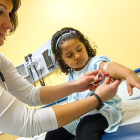I-Team In-Depth
Connecticut’s Halfhearted Battle: Response To Lead Poisoning Epidemic Lacks Urgency
|
It wasn’t until Bridgeport lead inspector Charles Tate stepped outside the house on Wood Avenue that he saw, immediately, where 2-year-old Rocio Valladares was being poisoned. The paint around a window at the back of the house was deteriorating. Beneath the window was Rocio’s favorite play area, a sloping basement door that was the perfect ramp for an energetic toddler. Next to the basement door was a patch of dirt where she loved to scratch with sticks. White chips of paint were visible in the dirt.

